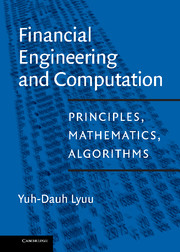Book contents
- Frontmatter
- Contents
- Preface
- Useful Abbreviations
- 1 Introduction
- 2 Analysis of Algorithms
- 3 Basic Financial Mathematics
- 4 Bond Price Volatility
- 5 Term Structure of Interest Rates
- 6 Fundamental Statistical Concepts
- 7 Option Basics
- 8 Arbitrage in Option Pricing
- 9 Option Pricing Models
- 10 Sensitivity Analysis of Options
- 11 Extensions of Options Theory
- 12 Forwards, Futures, Futures Options, Swaps
- 13 Stochastic Processes and Brownian Motion
- 14 Continuous-Time Financial Mathematics
- 15 Continuous-Time Derivatives Pricing
- 16 Hedging
- 17 Trees
- 18 Numerical Methods
- 19 Matrix Computation
- 20 Time Series Analysis
- 21 Interest Rate Derivative Securities
- 22 Term Structure Fitting
- 23 Introduction to Term Structure Modeling
- 24 Foundations of Term Structure Modeling
- 25 Equilibrium Term Structure Models
- 26 No-Arbitrage Term Structure Models
- 27 Fixed-Income Securities
- 28 Introduction to Mortgage-Backed Securities
- 29 Analysis of Mortgage-Backed Securities
- 30 Collateralized Mortgage Obligations
- 31 Modern Portfolio Theory
- 32 Software
- 33 Answers to Selected Exercises
- Bibliography
- Glossary of Useful Notations
- Index
30 - Collateralized Mortgage Obligations
Published online by Cambridge University Press: 19 September 2009
- Frontmatter
- Contents
- Preface
- Useful Abbreviations
- 1 Introduction
- 2 Analysis of Algorithms
- 3 Basic Financial Mathematics
- 4 Bond Price Volatility
- 5 Term Structure of Interest Rates
- 6 Fundamental Statistical Concepts
- 7 Option Basics
- 8 Arbitrage in Option Pricing
- 9 Option Pricing Models
- 10 Sensitivity Analysis of Options
- 11 Extensions of Options Theory
- 12 Forwards, Futures, Futures Options, Swaps
- 13 Stochastic Processes and Brownian Motion
- 14 Continuous-Time Financial Mathematics
- 15 Continuous-Time Derivatives Pricing
- 16 Hedging
- 17 Trees
- 18 Numerical Methods
- 19 Matrix Computation
- 20 Time Series Analysis
- 21 Interest Rate Derivative Securities
- 22 Term Structure Fitting
- 23 Introduction to Term Structure Modeling
- 24 Foundations of Term Structure Modeling
- 25 Equilibrium Term Structure Models
- 26 No-Arbitrage Term Structure Models
- 27 Fixed-Income Securities
- 28 Introduction to Mortgage-Backed Securities
- 29 Analysis of Mortgage-Backed Securities
- 30 Collateralized Mortgage Obligations
- 31 Modern Portfolio Theory
- 32 Software
- 33 Answers to Selected Exercises
- Bibliography
- Glossary of Useful Notations
- Index
Summary
Capital can be understood only as motion, not as a thing at rest.
Karl Marx (1818–1883), Das KapitalMutual funds combine diverse financial assets into a portfolio and issue a single class of securities against it. CMOs reverse that process by issuing a diverse set of securities against a relatively homogeneous portfolio of assets [660]. This chapter surveys CMOs. The tax treatment of CMOs is generally covered under the provisions of the Real Estate Mortgage Investment Conduit (REMIC) rules of 1986. As a result, CMOs are often referred to as REMICs [162, 469].
Introduction
The complexity of a CMO arises from layering different types of payment rules on a prioritized basis. In the first-generation CMOs, the sequential-pay CMOs, each class of bond would be retired sequentially. A sequential-pay CMO with a large number of tranches will have very narrow cash flow windows for the tranches. To further reduce prepayment risk, tranches with a principal repayment schedule were introduced. They are called scheduled bonds. For example, bonds that guarantee the repayment schedule when the actual prepayment speed lies within a specified range are known as planned amortization class bonds (PACs). PACs were introduced in August 1986 [141]. Whereas PACs offer protection against both contraction and extension risks, some investors may desire protection from only one of these risks. For them, a bond class known as the targeted amortization class (TAC) was created.
Scheduled bonds expose certain CMO classes to less prepayment risk. However, this can occur only if the redirection in the prepayment risk is absorbed as much as possible by other classes referred to as the support bonds or companion bonds.
- Type
- Chapter
- Information
- Financial Engineering and ComputationPrinciples, Mathematics, Algorithms, pp. 451 - 457Publisher: Cambridge University PressPrint publication year: 2001



